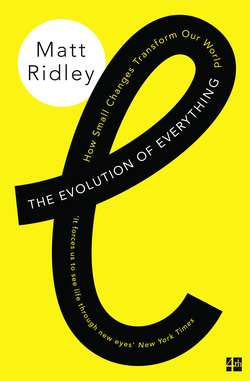Читать книгу The Evolution of Everything: How Small Changes Transform Our World - Matt Ridley, Matt Ridley - Страница 23
Astronomical improbability?
ОглавлениеThe evidence for gradual, undirected emergence of the opsin molecule by the stepwise alteration of the digital DNA language is strong. But there remains a mathematical objection. The opsin molecule is composed of hundreds of amino acids in a sequence specified by the appropriate gene. If one were to arrive at the appropriate sequence to give opsin its light-detecting properties by trial and error it would take either a very long time or a very large laboratory. Given that there are twenty types of amino acid, then a protein molecule with a hundred amino acids in its chain can exist in 10 to the power of 130 different sequences. That’s a number far greater than the number of atoms in the universe, and far greater than the number of nanoseconds since the Big Bang. So it’s just not possible for natural selection, however many organisms it has to play with for however long, to arrive at a design for an opsin molecule from scratch. And an opsin is just one of tens of thousands of proteins in the body.
Am I heading for a Lucretian swerve? Will I be forced to concede that the combinatorial vastness of the library of possible proteins makes it impossible for evolution to find ones that work? Far from it. We know that human innovation rarely designs things from scratch, but jumps from one technology to the ‘adjacent possible’ technology, recombining existing features. So it is taking small, incremental steps. And we know that the same is true of natural selection. So the mathematics is misleading. In a commonly used analogy, you are not assembling a Boeing 747 with a whirlwind in a scrapyard, you are adding one last rivet to an existing design. And here there has been a remarkable recent discovery that makes natural selection’s task much easier.
In a laboratory in Zürich a few years ago, Andreas Wagner asked his student João Rodriguez to use a gigantic assembly of computers to work his way through a map of different metabolic networks to see how far he could get by changing just one step at a time. He chose the glucose system in a common gut bacterium, and his task was to change one link in the whole metabolic chain in such a way that it still worked – that the creature could still make sixty or so bodily ingredients from this one sugar. How far could he get? In species other than the gut bacterium there are thousands of different glucose pathways. How many of them are just a single step different from each other? Rodriguez found he got 80 per cent of the way through a library of a thousand different metabolic pathways at his first attempt, never having to change more than one step at a time and never producing a metabolic pathway that did not work. ‘When João showed me the answer, my first reaction was disbelief,’ wrote Wagner. ‘Worried that this might be a fluke, I asked João for many more random walks, a thousand more, each preserving metabolic meaning, each leading as far as possible, each leaving in a different direction.’ Same result.
Wagner and Rodriguez had stumbled upon a massive redundancy built into the biochemistry of bacteria – and people. Using the metaphor of a ‘Library of Mendel’, in which imaginary building are stored the unimaginably vast number of all possible genetic sequences, Wagner identified a surprising pattern. ‘The metabolic library is packed to its rafters with books that tell the same story in different ways,’ he writes. ‘Myriad metabolic texts with the same meaning raise the odds of finding any one of them – myriad-fold. Even better, evolution does not just explore the metabolic library like a single casual browser. It crowdsources, employing huge populations of organisms that scour the library for new texts.’ Organisms are crowds of readers going through the Library of Mendel to find texts that make sense.
Wagner points out that biological innovation must be both conservative and progressive, because as it redesigns the body, it cannot ever produce a non-functional organism. Turning microbes into mammals over millions of years is a bit like flying the Atlantic while rebuilding the plane to a new design. The globin molecule, for example, has roughly the same three-dimensional shape and roughly the same function in plants and insects, but the sequences of amino acids in the two are 90 per cent different.
